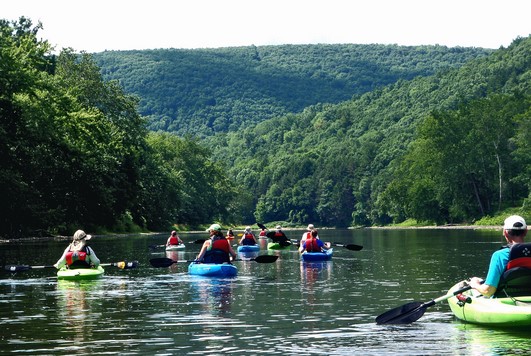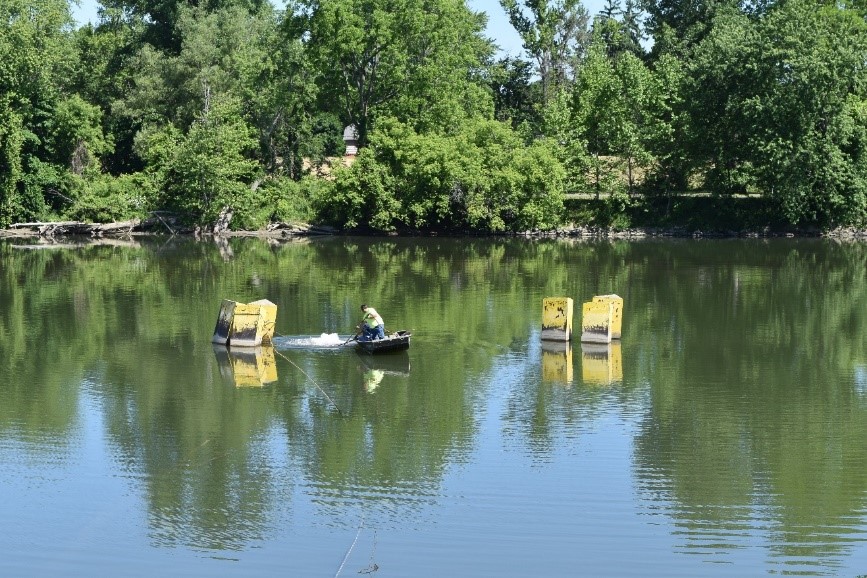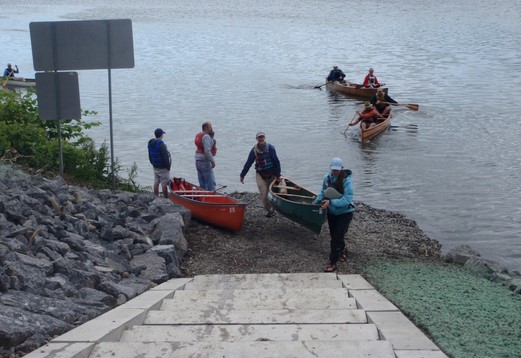
Our Lives Depend on Rivers
Rivers do so many things!
Energy: Early industrial era mills, shops and factories built near fast-flowing rivers where water could be used to power machines. Today steep flowing rivers provide free renewable energy for powering hydroelectric plants.
 Transportation: Rivers provide transportation for exploration, commerce and recreation.
Transportation: Rivers provide transportation for exploration, commerce and recreation.
Soil and water: River valleys and plains provide fertile soils, water for irrigation and plains to reduce flooding.
Fun: Rivers are fun—and fun can be lucrative. Rafting, fishing, swimming, hiking and wildlife watching all draw people—and therefore money—to areas with healthy rivers.
Economic boost: According to a report by the Outdoor Industry Association, outdoor recreation participants spend $86 billion annually on watersports (kayaking, stand-up paddling, rafting, canoeing, and motorized boating), the second highest revenue stream, with camping in the lead at $142 billion. Watersports directly support more than 800,000 jobs annually.
Habitat: River waters provide excellent habitat and food for many of Earth’s organisms. Countless species of fish, birds and other animals live in and along rivers and depend on them for their food. Many animals build their homes on riverbanks and riverbeds.
Connections: Rivers also connect ecosystems to one other and affect landscapes far beyond the apparent surface of the water. For example, wetlands provide breeding areas for many migratory birds, and rivers provide corridors for wildlife to move within and migrate as American landscapes become increasingly fenced off and fragmented.
Good for the soul: Rivers hold immeasurable spiritual and aesthetic value. If literature is any indication, wild and free rivers are a key metaphor for the human experience. Books have been written in honor of them. Poets use them as similes. Many religions have long held water as a part of their spiritual values. If there had been no wild and free Mississippi, there would be no Huck Finn. The river was a symbol of freedom and opportunity.
Comfort, beauty and peace: Scenic rivers provide stress relief better than any prescription or counseling services. The next sunny day visit a river and sit quietly on the grassy bank, with the sun warming your shoulders and watch the water flow by. You will be surprised how it rinses away your stress, troubles and cars.
Finally, more than 70% of Elmira’s drinking water comes from the Chemung River. It’s vital that the water withdrawal system is well-maintained.
That’s why you'll find Elmira Water Board employees were cleaning the water intake screens periodically, just upstream from the Walnut Street Bridge in Elmira. You can see the intake site from the bridge, about 1,000 yards away. It’s marked by six yellow columns protruding from the river. The site is owned by the Elmira Water Board.
 This photo shows workers using compressed air shooting out of a long and hollow metal wand to clear debris from the intake screens. The wand is connected to a hose that is connected to an industrial-size air compressor on the Southside shore of the river along Hudson Street.
This photo shows workers using compressed air shooting out of a long and hollow metal wand to clear debris from the intake screens. The wand is connected to a hose that is connected to an industrial-size air compressor on the Southside shore of the river along Hudson Street.
The yellow columns act as deflectors to protect the underwater pipes from damage or clogging by debris flowing downstream, especially during high water events. Paddlers should avoid paddling between the columns as it can be hazardous in a fast current.
River water is pulled through the screens and into two 24-inch pipes that run to the nearby pump house on the northside of the river on Windsor Avenue. The pump house sends the water to the filtration plant at the north end of Hoffman Street, where the water is filtered and chlorine and fluoride are added. The water is then distributed to more than 54,000 people in homes and businesses in the city of Elmira and portions of the towns of Elmira, Southport, Horseheads and Elmira Heights.
The Water Board pumps more than 2 billion gallons of water a year through various iron, copper, cement, and plastic pipes. Wells and reservoirs provide the rest of the water used by Water board customers.
 Downstream from the intake site is the Chase-Hibbard Dam, also owned by the Elmira Water Board. The dam keeps the water high enough to maintain a constant water level high enough to be safely withdrawn from the river.
Downstream from the intake site is the Chase-Hibbard Dam, also owned by the Elmira Water Board. The dam keeps the water high enough to maintain a constant water level high enough to be safely withdrawn from the river.
The present dam, built in the mid-1990s, is V-shaped, six feet high and nearly 1,000 feet wide. It has a 50-year lifespan. Several dams have been built at the site since the original dam, called the Record Dam, was built in the 1820s. It was only 18-inches tall and used to turn a water wheel to grind grain at a long-gone riverside grist mill.
Later dams were built by the Chase-Hibbard grist mill on the river.
 The dam is dangerous for paddlers and anglers. If a boat goes over the dam, the strong back current can easily trap the boat and paddlers in a hydraulic that cycles the boat and paddlers underwater and back to the surface over and over. In the mid-1970s, a fire chief and a firefighter drowned in a hydraulic in the similar Rock Bottom Dam on the Susquehanna River in Binghamton.
The dam is dangerous for paddlers and anglers. If a boat goes over the dam, the strong back current can easily trap the boat and paddlers in a hydraulic that cycles the boat and paddlers underwater and back to the surface over and over. In the mid-1970s, a fire chief and a firefighter drowned in a hydraulic in the similar Rock Bottom Dam on the Susquehanna River in Binghamton.
Anglers can frequently be seen walking across or fishing from the lip of the Elmira dam. The lip is covered with algae and seaweed that makes it easy to slip and fall into the hydraulic.
The Don Hall Portage around the dam features concrete steps and a paved trail that lets paddlers take their boats out of the river, above the dam, carry them along the trail to safely put them back in the river below the dam.